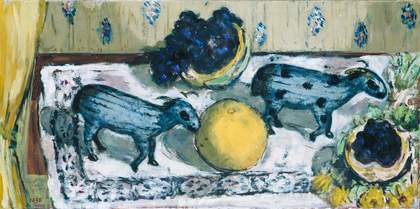
Marie-Louise von Motesiczky Still Life with Sheep 1938 © Marie-Louise von Motesiczky Charitable Trust
The Archive Gallery at Tate Britain has been renamed as the Marie-Louise von Motesiczky Archive Gallery, in recognition of the largest gift from a private trust to Tate Archive.
The newly named Marie-Louise von Motesiczky Archive Gallery at Tate Britain will open on 7 October with a unique display of over 350 items, drawing on the personal papers of émigré painter, Marie-Louise von Motesiczky (1906-1996), as well as related Tate Archive collections and paintings, generously supported by the Marie-Louise von Motesiczky Charitable Trust. The display is part of the regular six-monthly changing programme in the Archive Gallery.
Born into a wealthy Jewish family in Vienna, on her mother’s side, Motesiczky left school in 1920, and subsequently attended art classes in The Hague, Vienna, Paris, and Berlin. In 1927/8 she was invited by Max Beckmann to join his master class at the Städelschule in Frankfurt am Main. She and her mother Henriette left Vienna immediately after Hitler’s annexation of Austria in March 1938. At the beginning of 1939 they made their way to England which became their home for the rest of their lives. Marie-Louise’s brother Karl remained in Vienna; he was arrested in October 1942 for anti-Nazi resistance and sent to Auschwitz in February 1943, where he died of typhus four months later.
Following her ambition “If you could only paint a single good picture in your lifetime, your life would be worthwhile”, Motesiczky created over three hundred paintings, mainly portraits, self-portraits and still-lifes, in a career that spanned over seven decades. Many of these works now hang in major public galleries, including Tate, throughout the world.
The new display marks 80 years since the artist’s arrival in the UK and visualises the experience of exile, exploring its impact on Motesiczky’s art. It brings to life Motesiczky’s family background, their network of friendships and journey into exile. It also looks at the circle of fellow émigrés she moved in especially in Hampstead and her relationships with the two most important people in her life: the writer Elias Canetti (1905–1994) with whom she was emotionally involved for three decades, and her mother Henriette (1882-1978) who became Marie-Louise’s most remarkable subject. After Marie-Louise’s death her struggle to gain artistic recognition was taken over by the Marie-Louise von Motesiczky Charitable Trust.
The Marie-Louise von Motesiczky Charitable Trust has supported Tate Archives since 2012, when the personal papers of Marie-Louise von Motesiczky were presented to Tate. In addition to the major gift and support for the associated display, the Marie-Louise von Motesiczky Charitable Trust is supporting Tate Archive’s Émigré Art Archives project – a three-year cataloguing and digitisation project, comprising the professional papers of J.P. Hodin, the personal papers of David Mayor and his wider Viennese family, and the sketchbooks of Jankel Adler. This project also includes a public engagement programme of films, show and share sessions, and a symposium.
Alex Farquharson, Director of Tate Britain said, “This generous grant by the Marie-Louise von Motesiczky Charitable Trust is a fitting and lasting tribute to one among many émigré cultural figures who have enriched this country in inestimable ways. This and other grants by her Trust has helped to cement Tate Archive’s reputation as a centre of excellence for the study of émigré artists and art writers particularly those who fled Europe before the Second World War, which now number over 50 such collections.”
Frances Carey, Chair of the Marie-Louise von Motesiczky Charitable Trust said, “Tate has done Marie-Louise proud. It is so important for archival material of this kind to be properly looked after and made available in person and on line, Tate’s facilities and expertise ensure that people everywhere can understand the trajectory of not just a single individual but a whole milieu, and a chapter in history which resonates to this day.”
